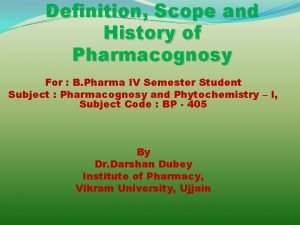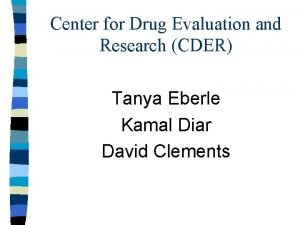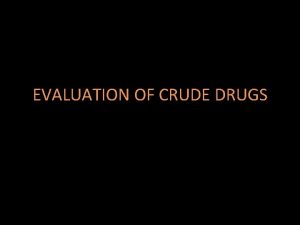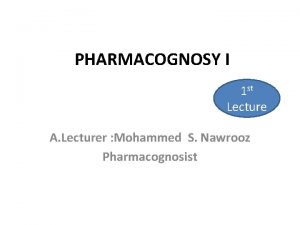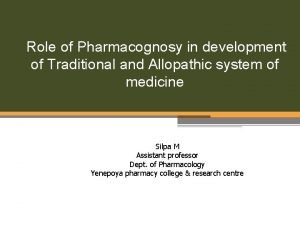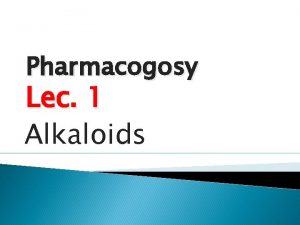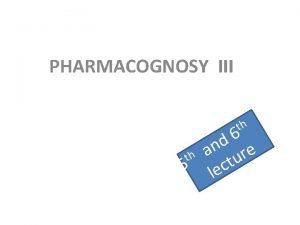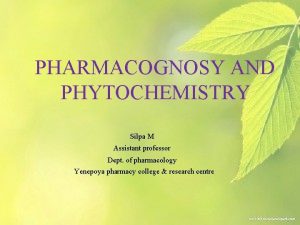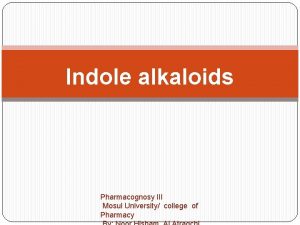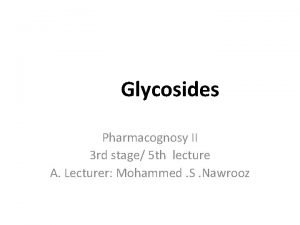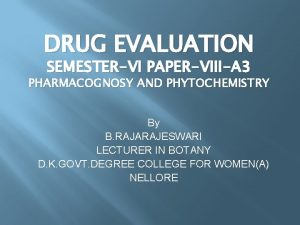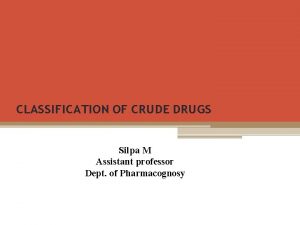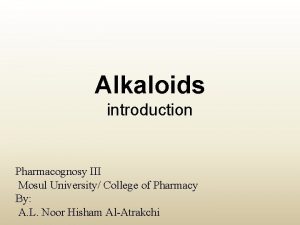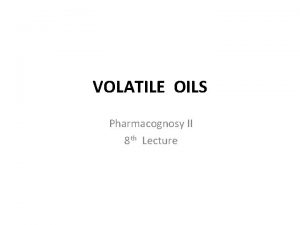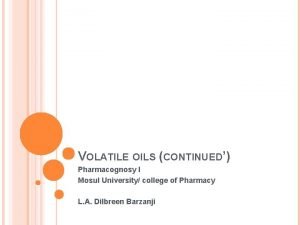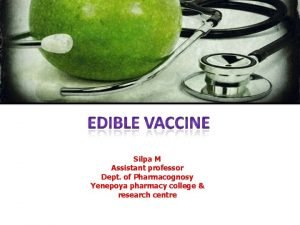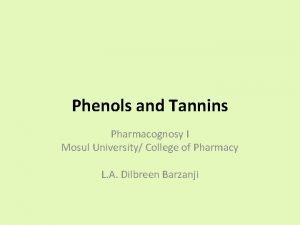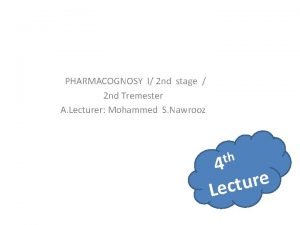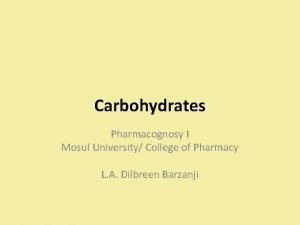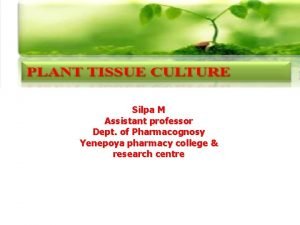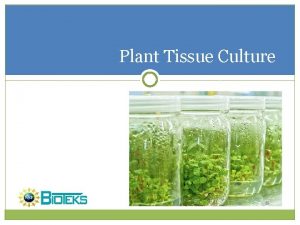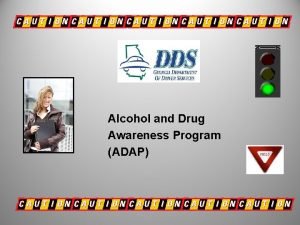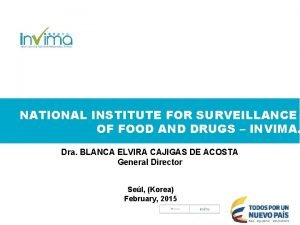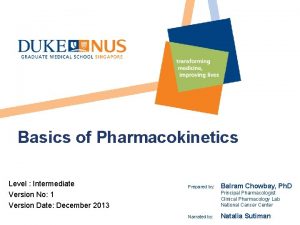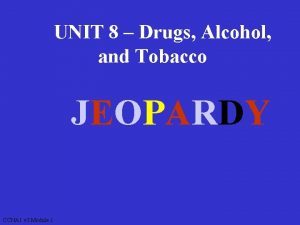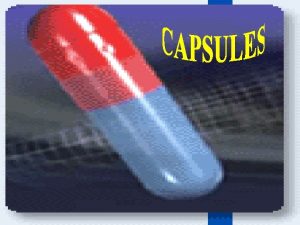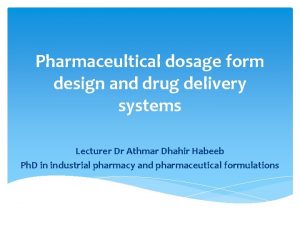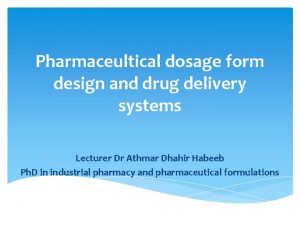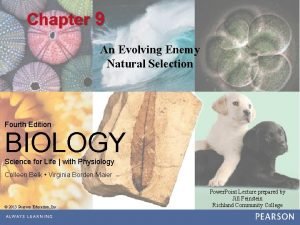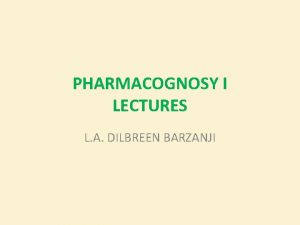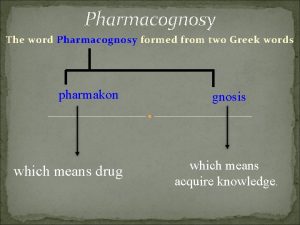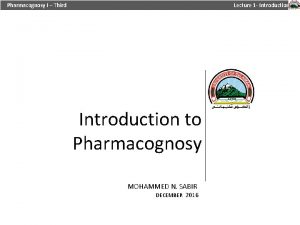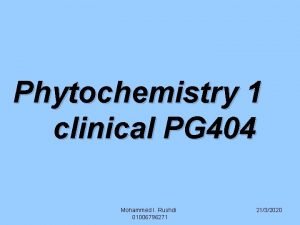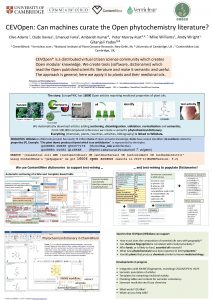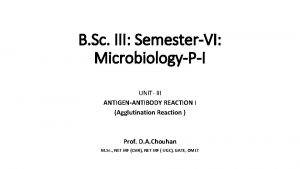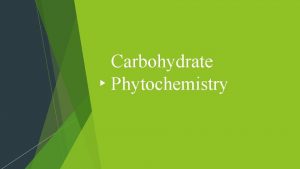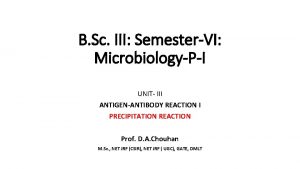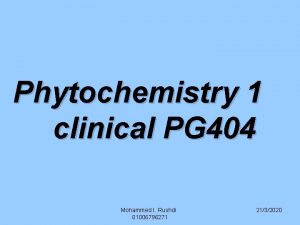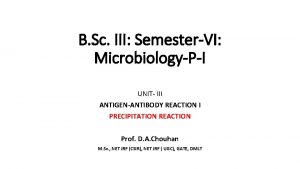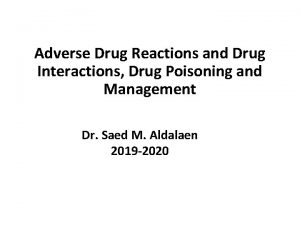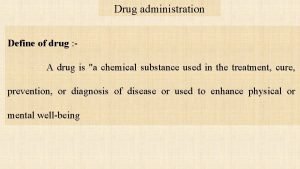DRUG EVALUATION SEMESTERVI PAPERVIIIA 3 PHARMACOGNOSY AND PHYTOCHEMISTRY










































- Slides: 42

DRUG EVALUATION SEMESTER-VI PAPER-VIII-A 3 PHARMACOGNOSY AND PHYTOCHEMISTRY By B. RAJARAJESWARI LECTURER IN BOTANY D. K. GOVT. DEGREE COLLEGE FOR WOMEN(A) NELLORE

Introduction: � � Drug evaluation may be defined as the determination of identity, purity and quality of a drug. Identity- identification of biological source of the drug. Quality- The quantity of the active constituents present. Purity- The extent of foreign organic material present in a crude drug.

Methods of Drug Evaluation: � � � The evaluation of a drug is done by studying its various properties are (1) Organoleptic property, (2) Microscopic property, (3) Biological property, (4) Chemical property, (5)Physical property.

Organoleptic (Morphological) Evaluation: Drug evaluation with the help of our sensory organs. � This evolution includes the study of external characters observed by sense organs. �

Study of Gross Morphology: � � � � � It includes the visual examination of drug. These drugs are classified into the following groups. Barks Underground structures Leaves Flowers Fruits Seeds Herbs

Barks: � Barks are part of the plant produced after secondary growth which constitutes to the drug. � Example: Cinnamomom, Cinchona, Ashoka, Kurchi.

Cinnamomom bark.

Underground Structures of plants : Underground Rhizomatic stems, Roots, Bulbils, and Tubers. � They are swollen due to the storage of food material like carbohydrates and other chemicals. � Examples: Ginger, Turmeric, Jatamansi. �

Ginger Jatamansi

Leaves: � The characteristics of the leaves help in the identification of the drugs. Senna leaves Tulasi leaves

Flowers: � � These are the reproductive organs of a plant. Ex : Saffron.

Fruits: � Fruits arise from the ovary and contain seeds. Examples : Almond, Amla

Seeds: � � Seeds are developed from the ovules in the carpels of the flowers. They are characterized by the hilium, micropyle, etc. Examples Flax seeds, Nuxvomica.

Study of sensory characters: � Ø Ø Colour, texture, odour and taste are useful in the evaluation of drugs. Colour Odour Taste Texture

Colour: � � Some drugs are green in colour. But they become shrink and colourless when dried. Terminalia(karaka).

Odour: � The odour of the drug may be either distinct or indistinct. � The term used for the drugs are aromatic, balsamic, spicy, etc. � Ex : Mentha, cloves.

Taste: � � � The drugs may be evaluated by taste also. The taste of the drug varies i. e. , bitter, pungent, spicy, etc. Examples: Ginger, Capsicum

Texture: � � Sometimes drugs can be examinated by their consistency and texture. Example: Colocynth.

Microscopic or Anatomical Evaluation: � This method allows a more detailed examination of a drug and it can be used to identify organized drugs by their known histological characters.

� � v v v Microscope can also be used for a quantitative evaluation of drugs and adulterated powders. This is done by counting a specific histological features such as, Stomatal Number Stomatal Index Vein-islet Number Palisade ratio Quantitative Microscopy Refractive Index

Stomatal Number: � � � The average number of stomata present per square millimeter of the epidermis is known as stomatal number. Stomatal number is relatively a constant for a particular species of same age. Example: Datura – 141 (upper epidermis).

Stomatal Index: � � � It is the percentage proportion of the number of stomata to the total number of epidermal cells. Stomatal number varies but stomatal index is relatively constant for a given species. Example: Atropa – 20. 0 -23. 0 (lower epidermis).

Vein-islet Number: � � The term “vein-islet” is used for the minute area of photosynthetic tissue. Vein-islet number is defined as the number of vein-islet per sq. mm. of leaf surface. It is constant for a given species of the plant. Example: Cassia senna (26).

Palisade ratio: � � � It represents the average number of palisade cells beneath one epidermal cell, using four continuous epidermal cells for the count. It is determined from powdered drugs. Example: Atropa belladona – 06 - 10

Quantitative Microscopy: It is an important analytical technique for powdered drug, especially when chemical and other methods of evaluation of crude drug fail as accurate measure of quality. � Example: Lycopodium – spores are very characteristic in shape and appearance. �

Physical Evaluation: � 1. 2. 3. 4. 5. 6. q ü Physical contents such as : Elasticity in fibers. Viscosity if drugs. Congealing point of volatile and fixed oils. Melting point. Boiling points. Water contents. Are some important parameters used in the evaluation of drugs. Ultraviolet light is also used for determining the fluorescence of extracts of some drugs.

Physical constants are extensively applied to the active principles of drugs, such as alkaloids, volatile oils, fixed oils, etc � ü ü ü ü ü A few of them are: Moisture content. Viscosity. Melting point. Optical Rotation. Refractive index. Ash Content. Extractive values. Volatile oil content. Rf values.

Viscosity: � � Viscosity of a liquid is constant at a given temperature and is an index of its composition. Example: Liquid paraffin – less than 64 centistokes.

Moisture content: � � Presence of moisture in a crude drugs can lead to its deterioration due to either activation of certain enzymes or growth of microbes. Moisture content can be determined by heating the drugs at 150˚C in an oven to a constant weight and calculating the loss of weight.

Melting point: � � � It is one of the parameters to judge the purity of crude drugs. The purity of the following crude drugs can be ascertained by determining their melting points in the range shown against each of them. Example: Coca butter (30˚ - 33˚C)

Optical rotation : � � � Many substances of biological origin, having a chiral center, can rotate the plane of polarized light either to right or to the left. The extent of rotation is expressed in degrees, plus(+) indicating rotation to the right and minus(-) indication rotation in the left. Such compounds are optically active and hence called optical rotation.

Refractive Index: � � � When a ray of light passes from one medium to another medium of different density, it is bent from its original path. It is measured by means of refractometer. Example: Arachis oil - 1. 4678 - 1. 4698

Ash Content: � � � The residue remaining after incineration of a known quantity of the air dried crude drug is known as the ash content of the drug. Ash simply represents the inorganic salts naturally occurring in drug or adhering to it or deliberately added to it as a form of adulteration. Example: Ashoka – 11. 00, Ginger – 6. 00

Extractive values: � � In crude drugs, sometimes the active chemical constitutes can not be determined by normal procedures. In such cases, water, alcohol or ether soluble extractive values are determined for evaluation of such drugs. Example: Water soluble extracts like Aloe Vera Alcohol soluble like Ginger.

Volatile oil content: � � Some crude drugs are standardized on the basis of their volatile oil contents. Weighed quantity of the drug is boiled with water in a round bottomed flask fitted with Clevenger apparatus. The distillate collected is graquated into volatile oil.

Rf values: � Chromatography is used for growth qualitative and quantitative evaluation of drugs. Rf values refers to the ratio of distance travelled by the solute to the distance moved by the solvent on a thin layer adsorbent. � Rf = Distance travelled by the compound(solute) � Distance travelled by the solvent


Chemical Evaluation: � � ü ü Determination of the active constituent in a drug by chemical tests is referred to as chemical evaluation. The following are various methods of chemical evaluation. Instrumental methods. Chemical Constants. Individual chemical tests. Micro chemical tests.

Instrumental methods: � � ü They make use of various instruments for evaluation like calorimetry, fluorimetry, spectrophotometry, etc. Chemical constants tests: These are like acid value, iodine, value and ester value etc are used for the identification of fixed oils and fats.

Individual chemical tests: � � ü q q These are the tests which are used for identifying particular drugs. Examples: Halpher’s test for cotton seed oil. Micro chemical tests: These are the tests which are carried on slides. Examples: Euginol in clove oil is precipitated has potassium euginate crystals.

Biological Evaluation: � � � It is employed when the drug can not be evaluated satisfactorily by chemical and physical methods. In this method, the response produced by the test drug on a living system is compared with that of the standard preparation. Such an activity is represented in units as International Units (I. U).

Indication of Biological Evaluation: � � When the chemical nature of the drug not known but is as an biological action. When the quantity of the drug is small and so it can not be evaluated chemically. Drugs which are different chemical composition but same biological activity. Example: Cardiac glycosides are evaluated by this method on cats, frogs or pigeons.
 Pharmacognosy definition history scope and development
Pharmacognosy definition history scope and development Types of adulteration of crude drugs
Types of adulteration of crude drugs Center for drug evaluation and research
Center for drug evaluation and research Vein islet number definition
Vein islet number definition Drug utilization review template
Drug utilization review template What is the scope of pharmacognosy
What is the scope of pharmacognosy Madar kabab chini tagar are the example of
Madar kabab chini tagar are the example of Aprophine
Aprophine Pharmacognosy alkaloids
Pharmacognosy alkaloids Difference between organized and unorganized drugs
Difference between organized and unorganized drugs Uses of alkaloids in pharmacognosy
Uses of alkaloids in pharmacognosy Glycosides in pharmacognosy
Glycosides in pharmacognosy Vein islet number example
Vein islet number example Coriander, fennel, datura are examples of
Coriander, fennel, datura are examples of Uses of alkaloids in pharmacognosy
Uses of alkaloids in pharmacognosy Volatile oils - pharmacognosy
Volatile oils - pharmacognosy Uses of volatile oil in pharmacognosy
Uses of volatile oil in pharmacognosy Edible vaccines in pharmacognosy
Edible vaccines in pharmacognosy Tannins in pharmacognosy
Tannins in pharmacognosy Alcohol soluble extractive value definition
Alcohol soluble extractive value definition Storage of crude drugs
Storage of crude drugs Sterculia gum pharmacognosy
Sterculia gum pharmacognosy Isovaler synonym
Isovaler synonym Bergmann's plating technique
Bergmann's plating technique Drug adulteration
Drug adulteration Applications of plant tissue culture in pharmacognosy
Applications of plant tissue culture in pharmacognosy Tissue culture applications
Tissue culture applications Arch drug and alcohol service
Arch drug and alcohol service Drugs that alter moods, thoughts, and sense perceptions
Drugs that alter moods, thoughts, and sense perceptions Active pharmaceutical ingredient sourcing
Active pharmaceutical ingredient sourcing Career opportunities in biotechnology and drug development
Career opportunities in biotechnology and drug development Tadra is an acronym for georgia’s
Tadra is an acronym for georgia’s National institute for food and drug surveillance
National institute for food and drug surveillance Individual prescription order system
Individual prescription order system Drug metabolism and pharmacokinetics
Drug metabolism and pharmacokinetics 12 core functions of counseling
12 core functions of counseling Drug and alcohol jeopardy
Drug and alcohol jeopardy Filling of hard gelatin capsules slideshare
Filling of hard gelatin capsules slideshare Shelf life of drug
Shelf life of drug Dosage forms and drug delivery systems
Dosage forms and drug delivery systems Forensic pharmacy
Forensic pharmacy Daisy drug and alcohol
Daisy drug and alcohol Natural selection and drug resistance
Natural selection and drug resistance
